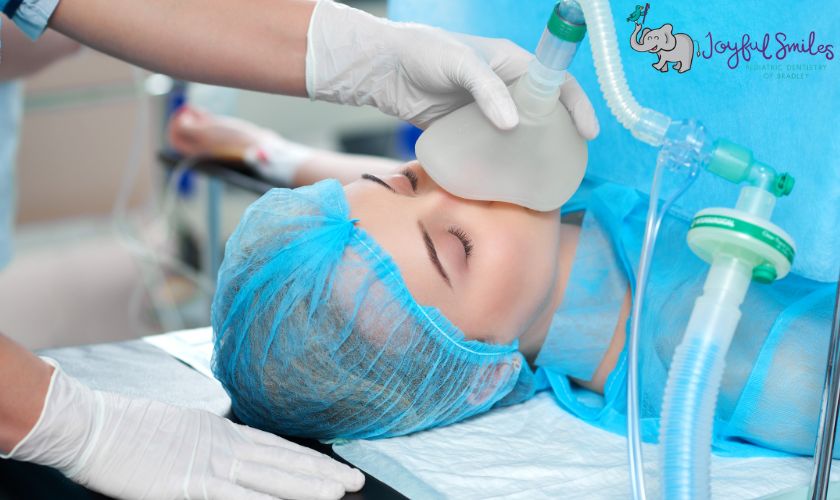Going to the dentist can be a scary experience for children, but imagine adding to the complexities of dental procedures such as fillings, extractions, or root canals. When it comes to these more intensive treatments, general anesthesia may be necessary to ensure that your child is safe and comfortable throughout their appointment. In this blog post, we’ll explore why general anesthesia is crucial in pediatric dentistry and how it affects a child’s oral health. So buckle up and let’s dive into this important topic!
What Is General Anesthesia?
General anesthesia is a medical procedure that involves the use of medication to induce a state of unconsciousness, allowing patients to undergo surgery or other invasive procedures without feeling any pain. In essence, it shuts down the patient’s awareness and ability to sense pain during dental treatment.
The medications used in general anesthesia include anesthetic gases and intravenous drugs that are administered by trained professionals such as dentists or anesthesiologists. The dosage depends on factors such as age, weight, and overall healthiness.
During the procedure, patients will be monitored closely using state-of-the-art equipment for their safety and well-being. This monitoring includes heart rate, blood pressure levels, and oxygen saturation levels in the blood among others.
It is crucial for pediatric dentistry since young children often experience anxiety when visiting the dentist due to fear of needles or painful treatments; therefore administering general anesthesia can help them relax while undergoing complex dental treatments.
However safe it may seem there are risks associated with General Anesthesia which should be discussed with your child’s doctor before deciding potential allergic reactions or complications from underlying medical conditions like asthma.
Why Is General Anesthesia Used In Pediatric Dentistry?
General Anesthesia is a medical procedure where the patient is put into a state of unconsciousness, which allows for more invasive procedures to be performed without causing discomfort or pain. In pediatric dentistry, general anesthesia is commonly used to help young patients receive necessary dental treatment.
Children can often feel anxious and scared about going to the dentist, especially when they need extensive work done. General anesthesia helps alleviate these fears by allowing children to sleep through their appointment and wake up with little or no memory of the procedure.
Additionally, some children may have special needs that make it difficult for them to sit still or cooperate during dental treatment. General anesthesia helps calm these children down and makes it easier for the dentist to perform any necessary procedures.
General anesthesia also enables dentists to treat multiple issues in one session instead of having several shorter appointments that may cause stress and anxiety in young patients. This approach saves time while providing better outcomes for both the child’s oral health and overall well-being.
General anesthesia has proven very effective in managing dental anxiety among children. By making treatments less stressful and more comfortable, pediatric dentists can help ensure a lifetime of healthy smiles!
How Does General Anesthesia Affect A Child’s Dentition?
General anesthesia is a common practice in pediatric dentistry, especially for children who have extensive dental needs or require more complex procedures. While it can be an effective way to manage pain and anxiety during dental treatment, many parents wonder how general anesthesia affects their child’s oral health.
During general anesthesia, the child is put into a deep sleep using medication administered through an IV. This ensures that they are completely unconscious and unable to feel any discomfort during the procedure. However, this also means that they are unable to move or swallow on their own.
As a result of not being able to swallow properly during the procedure, there may be some damage to the teeth from acid reflux caused by stomach contents entering the mouth. Additionally, prolonged use of pacifiers or thumb-sucking after general anesthesia can cause changes in tooth alignment and jaw development.
Parents need to talk with their dentist about these potential side effects before deciding on whether or not general anesthesia is necessary for their child’s dental treatment. Regular check-ups after the procedure will also help ensure that any issues are caught early and addressed promptly.
While there are some potential risks associated with general anesthesia in pediatric dentistry, it can still be an important tool in managing pain and anxiety for children with extensive dental needs.
What Are The After Effects Of General Anesthesia On A Child’s Oral Health?
After a child undergoes general anesthesia for dental treatment, it is common to experience some after-effects. These effects are usually temporary and will go away on their own without causing any long-term damage.
One of the most common side effects is feeling groggy or sleepy for several hours after the procedure. This can make it difficult to eat or drink anything immediately following the treatment. However, this should resolve itself once the anesthesia wears off completely.
Another possible effect of general anesthesia on a child’s oral health is dry mouth. When under sedation, saliva production decreases significantly, which can lead to a dry mouth sensation. Parents and caregivers should encourage children to drink plenty of water after the procedure.
In rare cases, some children may experience nausea or vomiting due to general anesthesia. If this happens, parents should try offering small sips of clear liquids like ginger ale or water until their child feels better.
Parents and caregivers need to follow post-treatment instructions provided by their dentist carefully to ensure proper healing and recovery from any potential side effects resulting from general anesthesia use during pediatric dentistry procedures.
Bottom Line
As parents, we want to make sure our children receive the best possible dental care. For some children, general anesthesia is crucial in making that happen. It allows them to receive necessary treatments without experiencing pain or fear.
General anesthesia is a powerful tool that should only be used when necessary and under the supervision of a trained professional. When it comes to pediatric dentistry, there are certain cases where it may be the best option for your child’s oral health.
It’s important to understand that general anesthesia does come with risks and potential side effects. However, these can often be mitigated through proper pre-operative preparation and post-operative care.
If you have concerns about your child receiving general anesthesia during their dental procedures, don’t hesitate to speak with their dentist or healthcare provider for more information. They can help address any questions or concerns you may have.
At the end of the day, every child is different and what works for one may not work for another. As parents, it’s up to us to educate ourselves on all available options and make decisions based on what we feel is best for our child’s overall health and well-being.
A: Yes, general anesthesia is considered to be a safe option when administered by an experienced medical professional.
A: It is possible, but it ultimately depends on the specific needs and circumstances of your child’s dental care. Your pediatric dentist will work with you to determine the best course of action.
A: While every medical procedure carries some level of risk, the use of modern technology and highly trained professionals greatly minimizes these risks.








